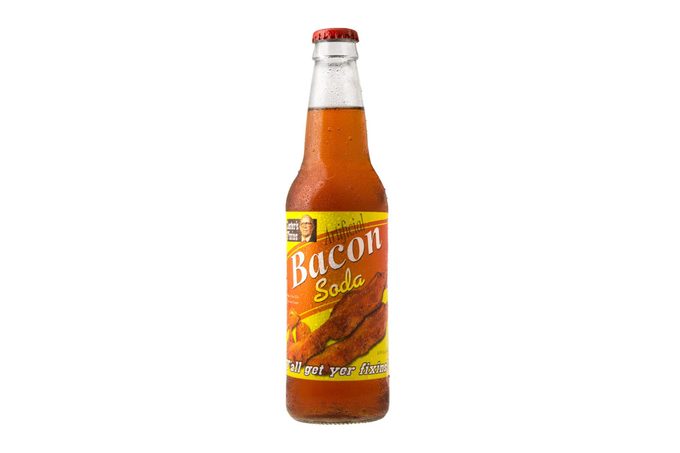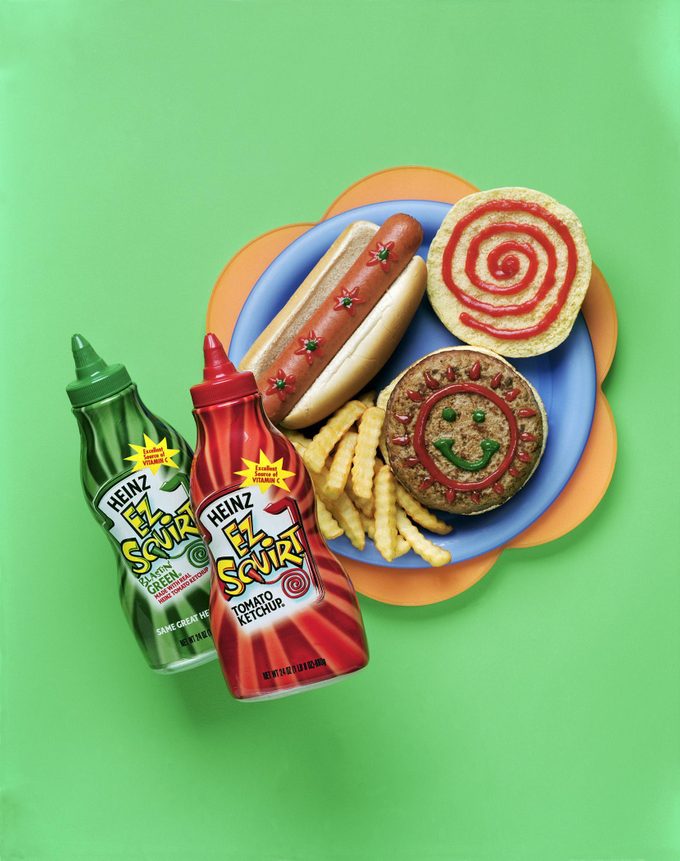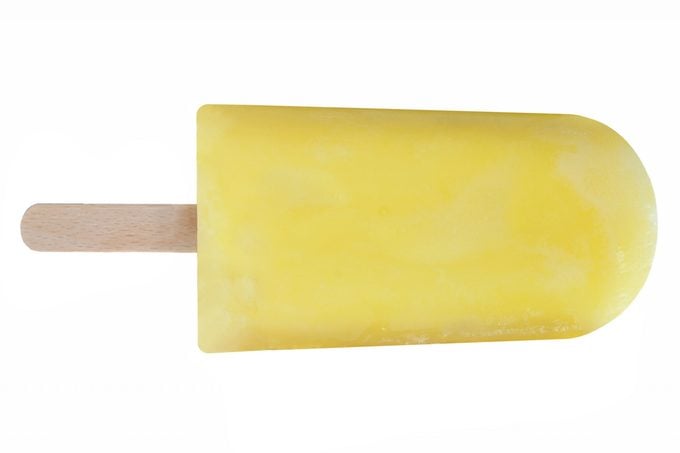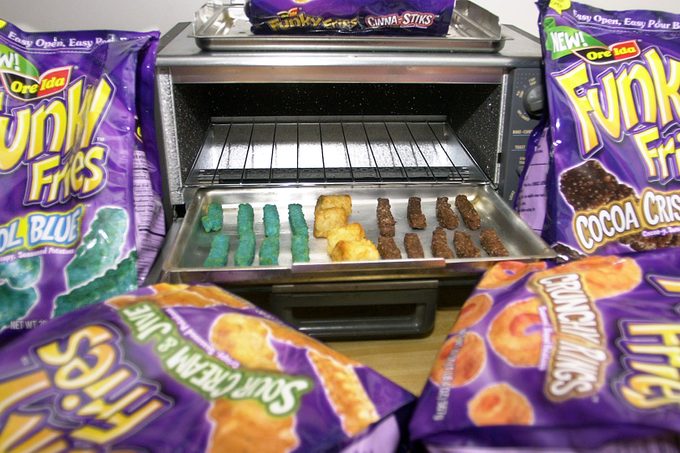Hey, hold our Crystal Pepsi, would ya? We've rounded up 25 of the biggest product fails in food history. And, yes, we're looking at you, Life Savers Soda.
25 Food Products That Flopped in a Major Way
LESTERS Bacon Soda

While you can still score a bottle of Bacon Soda on Amazon, you’d be hard-pressed to find this stuff in stores and with good reason. As one Amazon user by the name of Sergio stated in response to whether or not the price on the website was for a single bottle or a six-pack, “It’s one bottle and it’s not worth it, TRUST me!!!!!!” Oh, we do.
Life Savers Soda
On their own, Life Savers are a delightful, purse-friendly hard candy available in many varieties to suit your personal flavor preferences. However, in the 80s, the folks behind the iconic candy got a little ahead of themselves with a correlating carbonated beverage. Let’s just say Life Savers Soda didn’t exactly fly off grocery store shelves.
Jell-O Salad Gelatin
In some parts of the country, there’s a Jell-O salad for everything—typically it involves fruit, Cool Whip, and some kind of fun shape mold. However, in 1964 there must have been such a ruckus around making everything gelatinous that the Jell-O Salad Gelatin, in vegetable flavors, was introduced. It came in celery or mixed vegetable varieties. To say it was a flop is an understatement. But, hey, how a person consumes their veggies is their prerogative. For instance, we might turn our noses up at these weird foods people eat (and love!) around the world.
Colgate Kitchen Entrees
In business sometimes you just throw ideas against a wall to see what sticks. In 1982, toothpaste purveyor Colgate decided it might be time to go into the—wait for it—frozen food business. They introduced Colgate Kitchen Entrees, which included meals like Beef Lasagna. According to The Daily Meal, the venture was such a bust it actually caused a decline in Colgate toothpaste sales. These failed McDonald’s menu items were also pretty terrible.
Gerber Singles
Baby food giant Gerber had achieved so much success with their jarred stuff for the kiddos, they took a stab at marketing their puréed meals to college kids and those looking for a quick meal for one. They called them Gerber Singles and they came in flavors like Beef Burgundy and Blueberry Delight. Not surprisingly, even students on a budget weren’t willing to eat a meal of mush. CBS News reported the product hit shelves in 1974 (and were retired shortly thereafter).
Cheetos Lip Balm
Scented lip balm can be a nostalgic indulgence if you’re talking about cherry, strawberry, or even Dr. Pepper flavors. But at some point in 2009, someone thought it was a good idea to release a Cheetos Lip Balm. Yes, a lip product with the scent of the crunchy, bright orange snack. Truth be told, if we want to smell like Cheetos, we’ll just eat the product itself. If you’re ever in the market for healthier versions of your favorite junk foods, look no further.
Maxwell House Brewed Coffee
So close and yet so far! Maxwell House was a little ahead of their time when they released cartons of their ready-to-serve coffee that they instructed consumers to heat. This was clearly before cold brew coffee became a thing and it ultimately flopped for the brand. In another time, Maxwell House, this could have been huge…maybe.
Heinz EZ Squirt Ketchup

In a conference room somewhere, an executive must have thought, “You know what would make ketchup more fun? Colors!” In 2006, Heinz unveiled EZ Squirt Ketchup, offering the already beloved condiment in purple, green, or teal, housed in what looked like a school glue container. The result was pretty darn unappealing and after a six-year attempt to make EZ Squirt happen, it was discontinued, according to Bored Panda.
Coca-Cola BlāK
When big-time beverage flops come to mind, most consumers think of “New Coke,” that time Coca-Cola tried to be cute by updating the recipe for their beloved soda and it was received poorly. But we’d be remiss not to point out that the company has had many other misses, including Coca-Cola BlāK, a coffee-soda hybrid that hit the market with a thud. These weird products pale in comparison to these wacky food combinations people have admitted to trying.
Reddi-Bacon
There are some foods that are worth the wait because they’re best served fresh, so when the makers of Reddi-Whip decided to venture into the bacon business they came up short. According to CNN, Reddi-Bacon was individually foil-wrapped for putting in the toaster. However, the combination of the bacon grease and electric toaster made for some fire hazards and not-so-delicious-tasting bacon. Whomp whomp.
Cosmopolitan Yogurt
If you thought Colgate taking the plunge into the freezer section with frozen entrees was a bit of a leap, consider this: Cosmopolitan magazine once branded a line of yogurt. Eat This, Not That! says the product hit the refrigerated section in 1999 and, not surprisingly, wasn’t received well.
Coors Rocky Mountain Sparkling Water
When you think of cracking open a Coors, you think of an ice cold beer. However, in 1990 the company wanted to move into another beverage space and bottled water was a hot ticket. Unfortunately, Coors fans weren’t interested in a non-alcoholic product and the water quickly disappeared from shelves. Learn about more hilarious inventions that failed miserably.
Frito-Lay WOW! Chips
You know what they say about chips—you can’t eat just one. So when Frito-Lay revealed their new line of WOW! Chips based on fan favorites like Doritos but with barely any fat, snackers everywhere rejoiced. Unfortunately what made these chips so low in calories and fat was the ingredient olestra, which caused things like abdominal cramping and other serious side effects like diarrhea, according to The Daily Meal. No chip is worth that kind of pain, and WOW! quickly became a thing of the past.
Chiquita Frozen Juice Bars

Back in the 80s, Chiquita, best known for producing bananas, was tired of being pigeon-holed as simply a purveyor of the easy-peel fruit and wanted to branch out. According to The Daily Meal, they did so with Chiquita Frozen Juice Bars in 1987. Unfortunately, the product didn’t fly, despite a hefty investment in the production and marketing of the product.
Kellogg’s Breakfast Mates
Milk and cereal go together like peanut butter and jelly. Kellogg’s, the makers of some of America’s favorite cereals, wanted to make eating their products that much easier so they introduced Breakfast Mates in 1998. The product included a package of cereal, a small milk, and a spoon—essentially one-stop shopping for breakfast. The thing is, consumers didn’t think grabbing their own carton of milk from the fridge to pair with cereal was that inconvenient, and the product officially flopped by the following year.
Orbitz Soda
Companies always seem interested in finding the next great beverage and in 1997 Clearly Canadian placed its bets on Orbitz, a soda that, as Bored Panda points out, seriously resembled a lava lamp. A carbonated beverage accented with flavored gel orbs, the gimmick tanked with consumers and was ousted from stores.
Keurig Kold
Remember that time the coffee kings at Keurig tried to edge their way into the soda market? Neither did we, until Delish reminded us of the 2015 venture that dissolved in less than a year. The site says consumers simply couldn’t wrap their heads around Keurig and cola in the same way they could with coffee. If you’re brand-loyal to Coca-Cola, you need to read these secrets the company isn’t telling you.
Pepsi A.M.
Towards the end of the 80s, Pepsi wanted to give folks permission to drink a soda with their breakfast. Not a coffee drinker? Get your caffeine with a Pepsi A.M., they said! Business Insider says the product was touted as having “all the sugar and twice the caffeine” of a regular Pepsi. As appealing as that, er, sounds, it turns out if consumers wanted a morning soda, they’d drink a regular one. And with that Pepsi A.M. became extinct.
Yoplait Fizzix
Packaged like a Go-Gurt, Yoplait’s Fizzix was a bubbly twist on their signature product, meaning it was actually carbonated yogurt. It was introduced in 2006 and sold in six different flavors. As it turns out consumers weren’t really interested in eating fizzy yogurt and the product was discontinued.
Ore-Ida Funky Fries

In yet another case of brands trying to turn a product another color when it really served no purpose, Ore-Ida introduced their Funky Fries. What made them so funky? Oh, some were bright blue, some were cinnamon-flavored, and others were chocolate-flavored. CNN reports they hit shelves in 2002 and were promptly pulled from stores in 2003. While you might think wacky foods like these should be outlawed, there are plenty of foods that are actually illegal in the United States.
Stallone High-Protein Pudding
If it’s good enough for Rocky, it’s good enough for the rest of us, right? Wrong. Sylvester Stallone tried to hawk a high-protein pudding in the early aughts. Not only was it a flop, but it also resulted in a lawsuit, with accusations of breaches of contract and trade secrets getting thrown around, according to KPCC. Apparently, the drama surrounding this pudding was more interesting than the product itself.
Frito-Lay Lemonade
As a company, Frito-Lay is synonymous with a grocery store snack aisle, but at one time they hoped to snag a corner of the beverage market, too. They introduced Frito-Lay Lemonade hoping the sweet drink would pair well with their salty chips, but no one was buying what they were selling, literally.
Nestle Glowelle
In a time when we’re willing to take down collagen shots in our age-defying efforts, it isn’t so shocking that a major brand like Nestle would have attempted to profit off of a so-called beauty drink like their previously released Glowelle. It was released around 2008 but wasn’t long for this world as the product never caught on with U.S. customers.
Pepsi Blue
For a company that gets a lot of flack for its Crystal Pepsi creation, let’s not forget that they also tried their hand at another beverage that flopped—one Pepsi Blue. The berry-flavored soda failed to make an impact on consumers, although, in 2015 there was a petition to bring it back that proved unsuccessful. If you’ve ever wondered, here’s the real difference between Pepsi and Coke.
Starbucks Mazagran
Did we learn nothing from the Coca-Cola BlāK experience? Starbucks and Pepsi thought that as a tag team they could make a great coffee-cola beverage and they put their best efforts into the short-lived Mazagran product. Mazagran, referred to as a “sparkling coffee,” was released in 1995, according to Delish. Many of these companies probably wish these food product flops would remain in the realm of these secrets food manufacturers won’t tell you.
Every product is independently selected by our editors. If you buy something through our links, we may earn an affiliate commission.



















